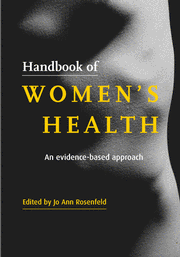Book contents
- Frontmatter
- Contents
- List of contributors
- Common abbreviations used in the text
- Normal blood values in women and during pregnancy
- Introduction
- 1 Singular health care of women
- Preventive care
- Psychosocial health
- Sexuality
- Genitourinary medicine
- Breast disorders
- Psychological disorders
- 24 Woman battering
- 25 Rape and the consequences of sexual assault
- 26 Depression and premenstrual syndrome
- 27 Addiction
- 28 Eating disorders
- Common medical problems
- Index
25 - Rape and the consequences of sexual assault
Published online by Cambridge University Press: 28 October 2009
- Frontmatter
- Contents
- List of contributors
- Common abbreviations used in the text
- Normal blood values in women and during pregnancy
- Introduction
- 1 Singular health care of women
- Preventive care
- Psychosocial health
- Sexuality
- Genitourinary medicine
- Breast disorders
- Psychological disorders
- 24 Woman battering
- 25 Rape and the consequences of sexual assault
- 26 Depression and premenstrual syndrome
- 27 Addiction
- 28 Eating disorders
- Common medical problems
- Index
Summary
Sexual assault is the fastest growing crime in America. Women are the targets of rape, the most underreported violent crime. Conviction rates for rape are poor. Sexual assault induces a life crisis, which inflicts major psychological and physiological trauma upon the victim. Health care providers must understand the horrific nature of this violent crime. Understanding the context of the assault, the type of rapist, as well as the sexual and violent acts forced on the victim will help physicians in providing appropriate care. Family physicians uniquely can monitor and provide care in the postassault period because many women do not report rapes or utilize rape crisis centers.
Definitions
“Asex offender is a person who has been legally convicted as a result of an overt act, committed by him for his own immediate sexual gratiication, which is contrary to the prevailing sexual mores of the society in which he lives and/or is legally punishable.”
Sexual crimes may be perpetrated by mentally disordered individuals or may be part of a person's underlying personality disorder. Some sexually deviant acts arise in the context of traumatic brain injury, psychoses or mental retardation. Some authors believe that rapists meet criteria for having a paraphilia.
Rape is the nonconsensual oral, anal, or vaginal penetration obtained by force, with threat of bodily harm, or when the victim is incapable of giving consent. The legal definition in the USA varies from state to state. Most deinitions include the use of threat, duress, physical force, intimidation, or deception, sexual contact, and nonconsent of the victim.
[…]
- Type
- Chapter
- Information
- Handbook of Women's HealthAn Evidence-Based Approach, pp. 422 - 436Publisher: Cambridge University PressPrint publication year: 2001

